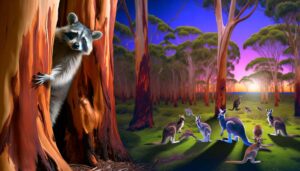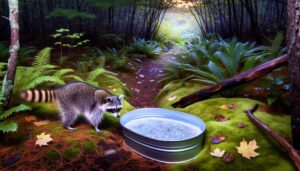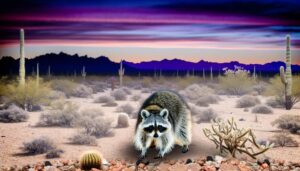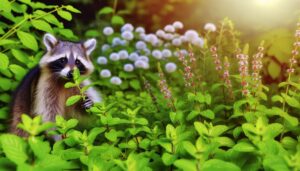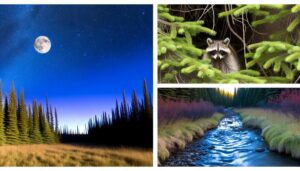Does Raccoon Live in Chaparral Habitats?
Raccoons are indeed found in the chaparral biome. They thrive due to their omnivorous diet and adept problem-solving skills.
Chaparral ecosystems, characterized by hot, dry summers and mild, wet winters, provide diverse food sources such as fruits, nuts, small mammals, and insects. Raccoons exploit seasonal water sources and use tree hollows, deserted burrows, and dense vegetation for shelter.
Predators like coyotes and environmental threats such as wildfires pose risks. Evidence of their presence includes direct observations, camera trap data, and track analysis.
For more insights on raccoon adaptability and survival strategies in the chaparral, explore further.
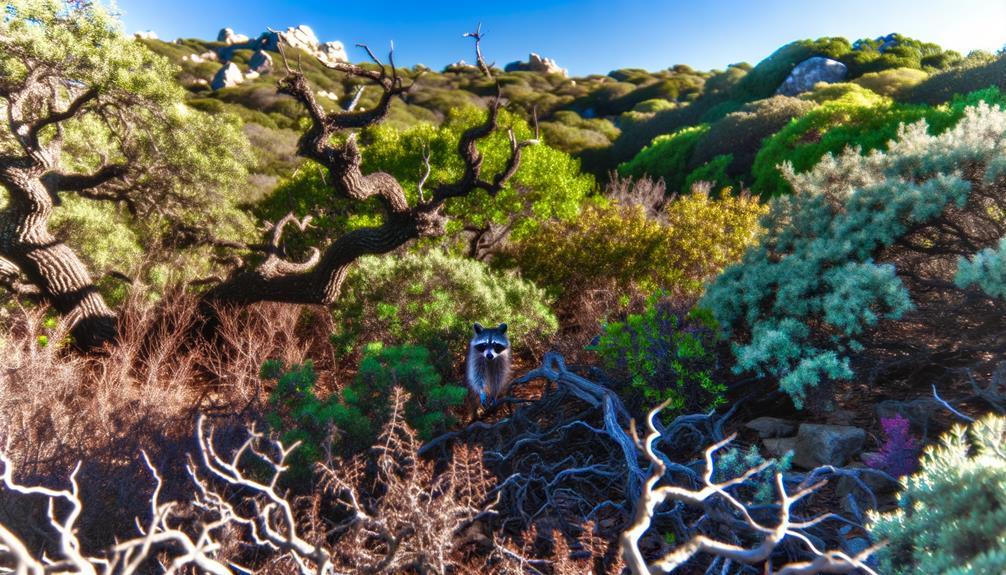
Key Takeaways
- Raccoons inhabit chaparral ecosystems, utilizing tree hollows, deserted burrows, and thick vegetation for shelter.
- They exploit diverse food sources like fruits, nuts, small mammals, and carrion in chaparral regions.
- Their nocturnal habits and dexterous forepaws facilitate effective foraging and resource exploitation in chaparral biomes.
- Raccoons adapt to seasonal water availability, using intermittent water sources and seeking alternatives during dry spells.
- Evidence from camera traps, tracks, and scat samples confirms raccoons' presence and activities in chaparral ecosystems.
Raccoon Habitat Overview

Raccoons (Procyon lotor) are highly adaptable mammals that inhabit a wide range of environments, from urban areas to various natural ecosystems including forests, wetlands, and grasslands. Data indicates that their home range can vary between 1 to 20 square kilometers, depending on resource availability (Gehrt, 2003).
These nocturnal omnivores demonstrate remarkable flexibility in their diet, consuming fruits, nuts, insects, and small vertebrates. They are often found near water sources, which are essential for their foraging behavior. Studies reveal that raccoons possess proficient problem-solving skills, allowing them to exploit diverse habitats effectively (Prange et al., 2004).
This adaptability to varied settings underscores their resilience and facilitates their widespread distribution across North America.
Characteristics of Chaparral
The chaparral biome is characterized by a Mediterranean climate with hot, dry summers and mild, wet winters, which greatly influences its ecological dynamics.
This region supports a unique assemblage of plant species adapted to periodic drought and fire, including evergreen shrubs and sclerophyllous vegetation.
Wildlife in the chaparral exhibits various adaptations to these environmental conditions, enabling survival and coexistence within this specialized habitat.
Climate and Weather Patterns
Chaparral ecosystems are characterized by hot, dry summers and mild, wet winters, creating a unique climate that greatly influences the flora and fauna adapted to this environment.
Average summer temperatures can exceed 30°C, while winter temperatures typically range between 10°C to 15°C. Annual precipitation varies from 250 to 750 millimeters, mainly occurring between November and April.
This distinct Mediterranean climate results in prolonged drought periods during summer, which impacts water availability to a large extent. Fire regimes are also integral, with natural fires occurring every 30 to 40 years, facilitating ecological succession.
The weather patterns contribute to a landscape dominated by sclerophyllous vegetation, which has evolved to withstand both aridity and periodic fires, shaping a resilient yet vulnerable ecosystem.
Unique Plant Species
Sclerophyllous vegetation, which includes species such as manzanita, chamise, and scrub oak, exhibits adaptations like thick, waxy leaves and deep root systems to thrive in the chaparral's harsh conditions. These morphological traits minimize water loss and enhance drought resistance, essential for survival in environments characterized by hot, dry summers and mild, wet winters.
Manzanita (Arctostaphylos spp.) possesses red bark and evergreen leaves, while chamise (Adenostoma fasciculatum) is notable for its needle-like foliage and fire-resilient properties. Scrub oak (Quercus berberidifolia) exhibits a dense, shrubby form and robust root network.
Such adaptations not only secure their persistence but also maintain the ecological stability of the chaparral biome, which is prone to periodic wildfires and nutrient-poor soils.
Wildlife Adaptations
How do various animal species adapt to the extreme conditions of the chaparral to ensure their survival and reproduction?
The chaparral biome, characterized by hot, dry summers and mild, wet winters, necessitates unique adaptations.
Mammals such as the coyote (Canis latrans) exhibit nocturnal behavior to avoid daytime heat, while reptiles like the western fence lizard (Sceloporus occidentalis) have developed reflective scales to mitigate solar radiation.
Avian species, including the California quail (Callipepla californica), employ cryptic coloration to evade predators.
Moreover, water conservation is critical; species like the kangaroo rat (Dipodomys spp.) utilize metabolic water from food to minimize reliance on external water sources.
Collectively, these adaptations highlight the resilience and ingenuity of chaparral wildlife.
Raccoon Adaptability
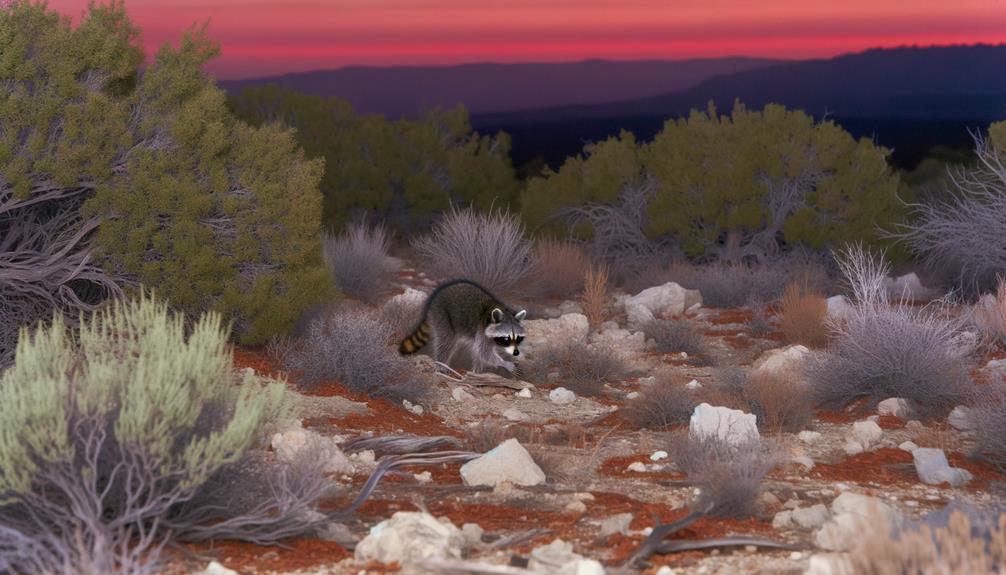
Raccoons exhibit remarkable adaptability, allowing them to thrive in diverse habitats ranging from urban environments to natural ecosystems like the chaparral. This adaptability is underpinned by several key physiological and behavioral traits. Specifically, raccoons possess:
- Dexterous forepaws: These enable raccoons to manipulate and access various food sources.
- Omnivorous diet: Raccoons can consume a wide range of foods, enhancing their survival across different ecosystems.
- Nocturnal habits: Activity during the night reduces competition and predation risks.
These characteristics facilitate the raccoon's ability to exploit resources within the chaparral, characterized by dense, shrubby vegetation and a Mediterranean climate. By leveraging their flexible foraging strategies and behavioral plasticity, raccoons can effectively navigate and inhabit the chaparral biome.
Food Sources in Chaparral
Building on their adaptability, a critical aspect of raccoons' survival in the chaparral is their ability to exploit a diverse array of food sources available within this biome.
The chaparral ecosystem offers a heterogeneous mix of plant and animal matter that raccoons can utilize. Seasonally available fruits, nuts, and seeds constitute a substantial portion of their diet. Additionally, raccoons exhibit opportunistic predation on small mammals, birds, and insects, further broadening their nutritional intake.
Studies indicate that raccoons also scavenge carrion and human refuse, underscoring their dietary flexibility. This omnivorous feeding behavior not only facilitates energy acquisition but also mitigates the ecological pressures of food scarcity, making raccoons well-suited for the variable conditions of the chaparral.
Water Availability
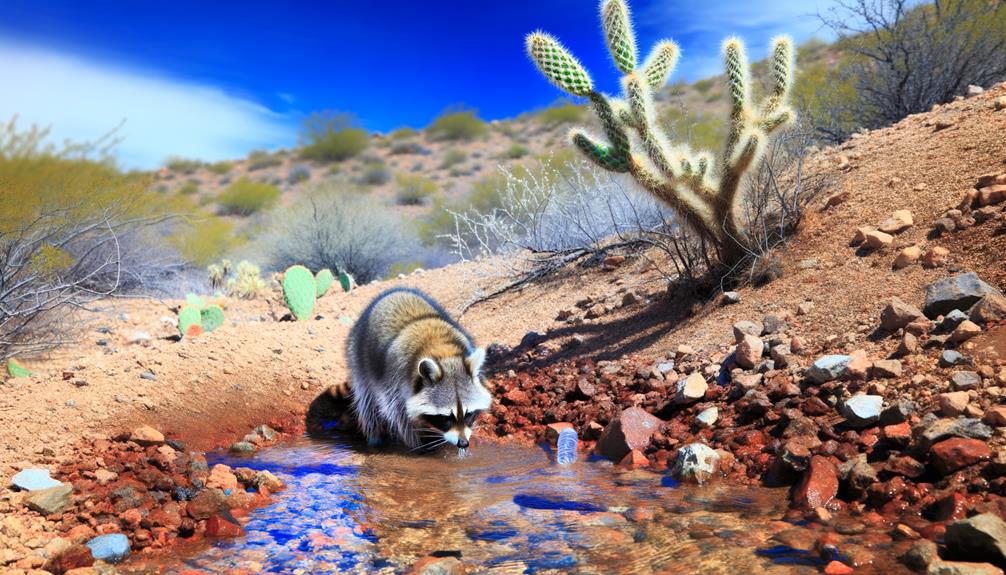
Water availability in the chaparral is characterized by the presence of natural water sources such as streams and seasonal pools. However, these sources often experience significant fluctuations, leading to periods of water scarcity, particularly during the dry summer months.
This seasonal variability in water supply is a critical factor influencing the habitat suitability for raccoons in the chaparral ecosystem.
Natural Water Sources
Natural water sources in chaparral ecosystems are often intermittent, influenced by seasonal rainfall and drought cycles. This variability impacts the availability of water for wildlife, including raccoons.
Key natural water sources in these habitats include:
- Ephemeral streams: Flow primarily during and shortly after rain events.
- Seasonal pools: Temporary ponds that form in depressions during wetter periods.
- Seepage areas: Groundwater emerging sporadically at the surface.
These water sources are critical for sustaining the diverse biota of chaparral regions.
Data indicate that raccoons rely on these intermittent sources for hydration and foraging. Their ability to exploit such variable resources demonstrates their adaptability to the dynamic environmental conditions of the chaparral.
Quantitative studies are essential to further elucidate these dependencies.
Seasonal Water Scarcity
Seasonal water scarcity in chaparral ecosystems presents significant challenges for wildlife, including raccoons, as the availability of hydration sources declines markedly during dry periods. Precipitation in chaparral regions typically occurs in winter, leading to prolonged dry spells in summer.
Studies indicate that water sources such as streams and ponds can dry up, reducing access to essential hydration. This scarcity forces raccoons to adapt by seeking alternative water sources, often venturing closer to human habitation. Additionally, limited water availability can impact their food sources, as vegetation and prey species also suffer from dehydration.
Understanding these dynamics is essential for conservation efforts aimed at sustaining raccoon populations and overall biodiversity in chaparral habitats.
Shelter Options
Raccoons in chaparral ecosystems utilize a variety of shelter options, including tree hollows, deserted burrows, and thick vegetation, to protect themselves from predators and environmental elements. These shelters play essential roles in their daily survival and overall fitness. Research indicates that raccoons exhibit adaptive behavior when selecting shelters based on availability and environmental conditions.
Tree hollows provide elevated protection and are often preferred due to reduced predation risk.
Deserted burrows are often repurposed from other animals, offering subterranean refuge.
Thick vegetation serves as camouflage and a barrier against harsh weather conditions.
Investigations have shown these shelter options are vital for maintaining raccoon populations in chaparral regions, directly influencing their reproductive success and longevity.
Predators and Threats
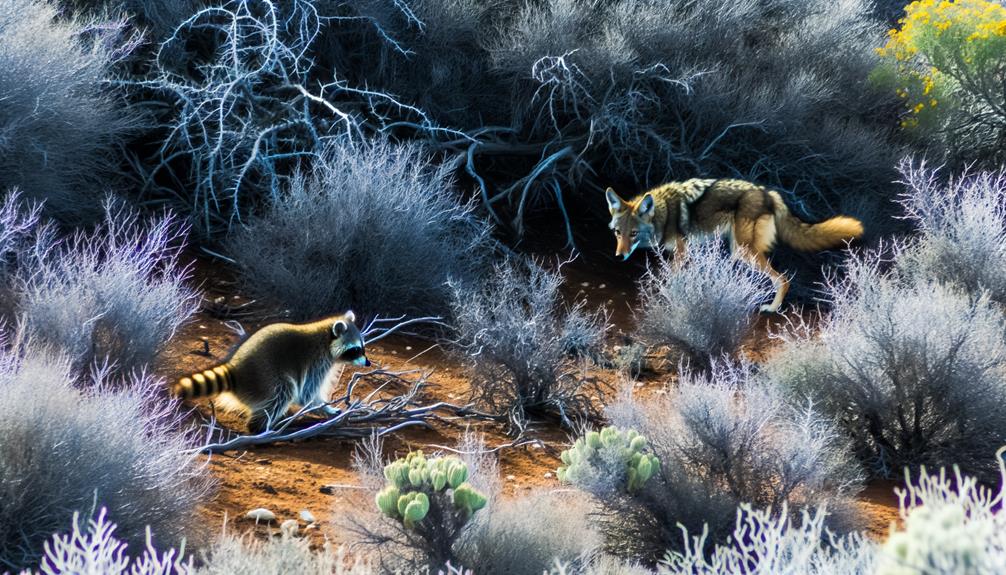
Despite their adaptive behaviors and varied shelter options, raccoons in chaparral ecosystems face notable threats from predators and environmental hazards. Key predators include coyotes (Canis latrans), bobcats (Lynx rufus), and large birds of prey, which exert considerable predation pressure on raccoon populations.
Additionally, raccoons are susceptible to disease outbreaks, such as canine distemper and rabies, which can greatly impact their numbers. Environmental threats include wildfires, which are frequent in chaparral regions and can destroy habitats, forcing raccoons to migrate or perish.
Moreover, human activities such as urbanization and road traffic present added risks. Data indicate that road mortality constitutes a substantial cause of death among raccoons in these areas, further emphasizing the multifaceted nature of their threats.
Evidence of Presence
In chaparral ecosystems, evidence of raccoon presence is substantiated through direct observations, camera trap data, and the identification of tracks and scat. Field studies have documented raccoons engaging in nocturnal activities, foraging for food, and utilizing water sources.
Camera traps have captured numerous images and videos of raccoons, providing concrete visual evidence of their presence. Additionally, the identification of raccoon tracks and scat within these environments further supports their habitation.
Key evidence includes:
- Direct Observations: Field researchers have noted raccoons during night surveys.
- Camera Trap Data: Remote cameras have recorded raccoons' presence and behaviors.
- Tracks and Scat: Distinctive paw prints and scat samples corroborate their activity.
These data points collectively affirm that raccoons inhabit chaparral regions.
Conclusion
In the mosaic of the chaparral ecosystem, raccoons emerge as adaptable weavers, threading through the unique tapestry of flora and fauna.
The chaparral, with its diverse food sources, water availability, and shelter options, provides a viable habitat for these nocturnal creatures.
Despite the looming shadows of predators and environmental threats, raccoons' resilience enables their survival.
Hence, the raccoon's presence in the chaparral symbolizes nature's intricate balance and the enduring adaptability of wildlife within dynamic environments.

